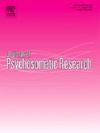精神痛苦和失眠的同时发生与更严重的肌肉骨骼疼痛有关——1966年芬兰北部出生队列研究
IF 3.5
2区 医学
Q2 PSYCHIATRY
引用次数: 0
摘要
目的:本横断面研究展示了过去12个月内患有精神痛苦和/或失眠的普通人群中肌肉骨骼(MSK)疼痛维度的差异。方法:研究1966年芬兰北部出生队列(NFBC1966)的参与者(n = 4316)。根据患者的精神困扰和失眠状况(共发性精神困扰和失眠[CMI]、孤立性精神困扰和失眠[M]、无精神困扰和失眠[AMI])将患者分为三组。AMI组作为主要分析的参照。MSK疼痛的维度包括频率、恼人程度(数值评定量表[NRS] 0-10)、疼痛强度(NRS)和疼痛部位数量(1-8)。使用多项和一般线性回归分析来研究相关性,并对性别、教育程度、躯体疾病数量和身体活动进行了调整。结果:与所有其他组相比,CMI组在各个维度上都有更严重的疼痛(每日疼痛调整OR 5.08, 95% CI 3.43-7.51;麻烦事调整β 1.7, 95% CI 1.5-2.0;强度校正β 1.4, 95% CI 1.2-1.7;疼痛部位调整数β 1.2, 95% CI 1.0-1.4)。与AMI组相比,I组和M组也与所有疼痛维度相关,但与CMI组相比,其程度较低。结论:失眠、精神痛苦与重度MSK疼痛共存,且共存时MSK疼痛程度有加重的趋势。因此,在全面评估MSK疼痛症状时,考虑失眠和精神痛苦是很重要的。本文章由计算机程序翻译,如有差异,请以英文原文为准。
Co-occurrence of mental distress and insomnia associates with more severe musculoskeletal pain – Northern Finland Birth Cohort 1966 study
Objective
This cross-sectional study demonstrates the differences in the dimensions of musculoskeletal (MSK) pain between participants with mental distress and/or insomnia among general population with MSK pain within the past 12 months.
Methods
Participants of Northern Finland Birth Cohort 1966 (NFBC1966) were studied (n = 4316). They were divided into groups based on their mental distress and insomnia status (co-occurring mental distress and insomnia [CMI], isolated mental distress [M] and insomnia [I], and absence of both [AMI]). The AMI group was used as a reference for the main analyses. The dimensions of MSK pain included frequency, bothersomeness (Numerical Rating Scale [NRS] 0–10), intensity of pain (NRS), and number of pain sites (1–8). Multinomial and general linear regression analyses were used to study the associations, and adjustments were made for sex, education, number of somatic diseases, and physical activity.
Results
The CMI group was associated with more severe pain in every dimension when contrasted to all other groups (daily pain adjusted OR 5.08, 95 % CI 3.43–7.51; bothersomeness adjusted β 1.7, 95 % CI 1.5–2.0; intensity adjusted β 1.4, 95 % CI 1.2–1.7; number of pain sites adjusted β 1.2, 95 % CI 1.0–1.4). Compared to AMI, I and M groups also had relationships with all pain dimensions, but with lower magnitude compared to the CMI group.
Conclusions
The results suggest that insomnia and mental distress co-exist with more severe MSK pain, and when co-occurring, MSK pain severity tends to increase. Therefore, contemplating insomnia and mental distress are important to consider when comprehensively evaluating MSK pain symptoms.
求助全文
通过发布文献求助,成功后即可免费获取论文全文。
去求助
来源期刊
CiteScore
7.40
自引率
6.40%
发文量
314
审稿时长
6.2 weeks
期刊介绍:
The Journal of Psychosomatic Research is a multidisciplinary research journal covering all aspects of the relationships between psychology and medicine. The scope is broad and ranges from basic human biological and psychological research to evaluations of treatment and services. Papers will normally be concerned with illness or patients rather than studies of healthy populations. Studies concerning special populations, such as the elderly and children and adolescents, are welcome. In addition to peer-reviewed original papers, the journal publishes editorials, reviews, and other papers related to the journal''s aims.

 求助内容:
求助内容: 应助结果提醒方式:
应助结果提醒方式:


